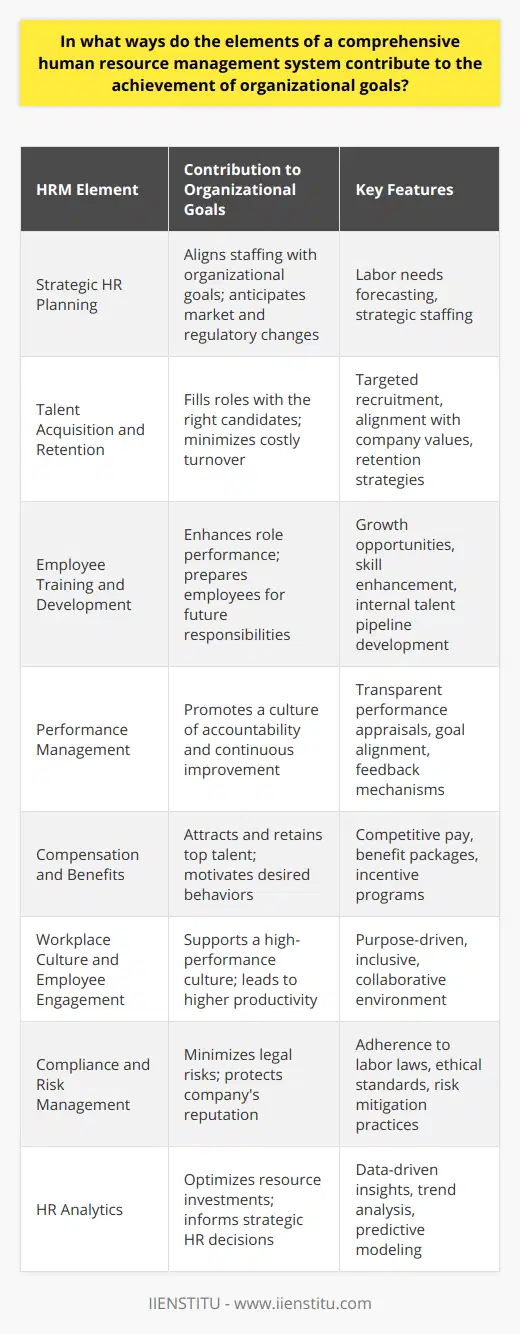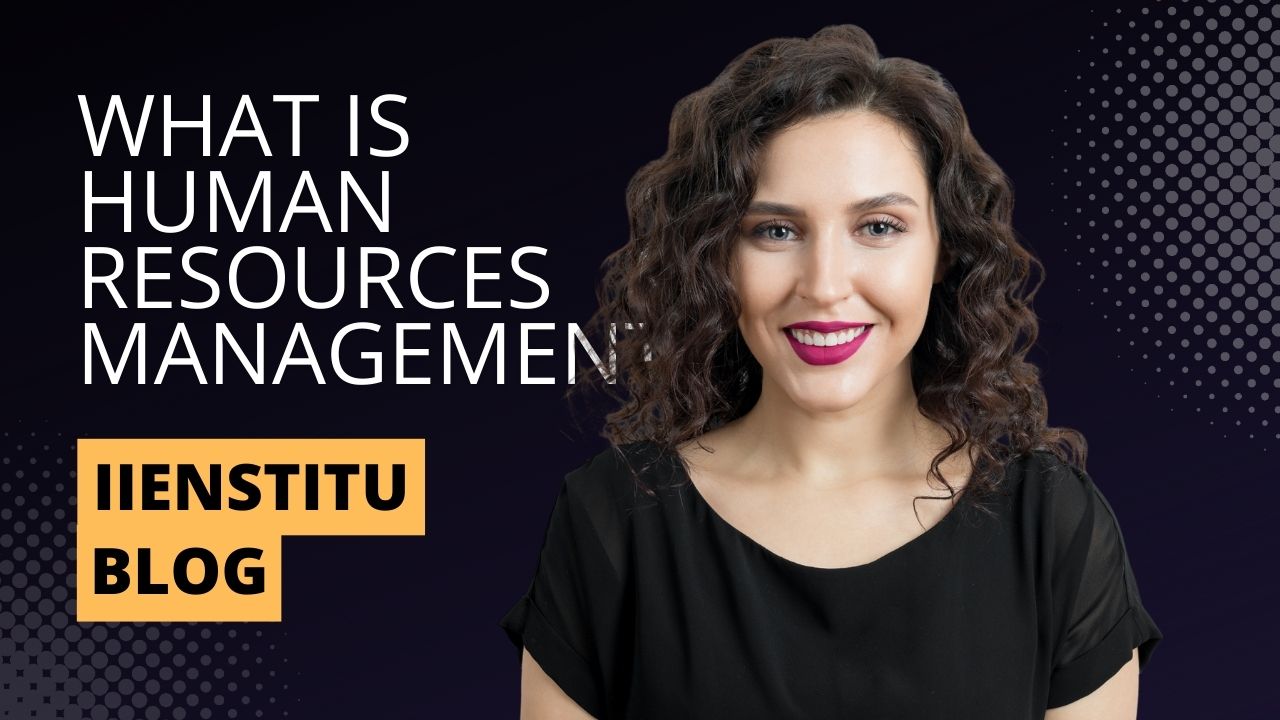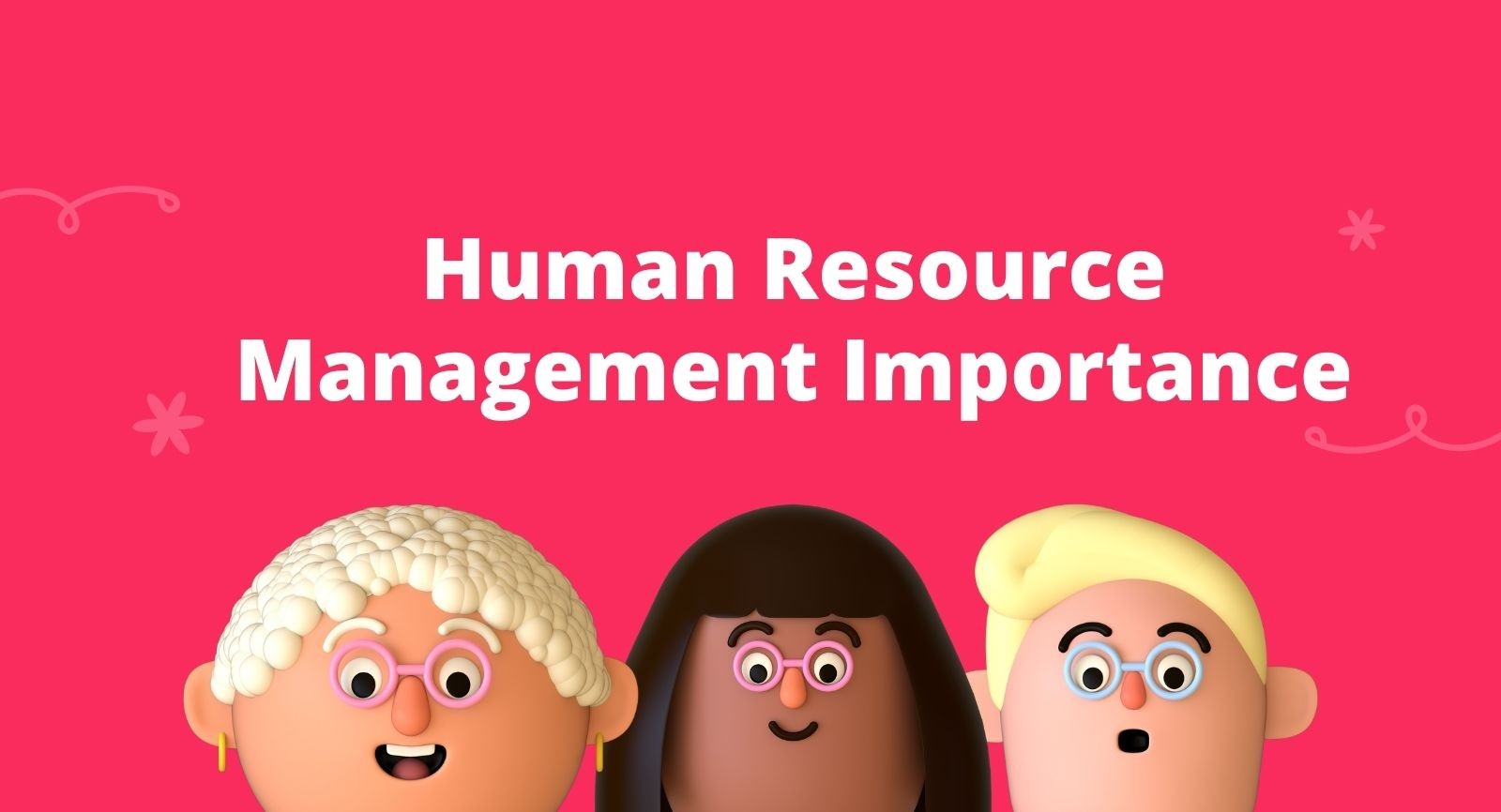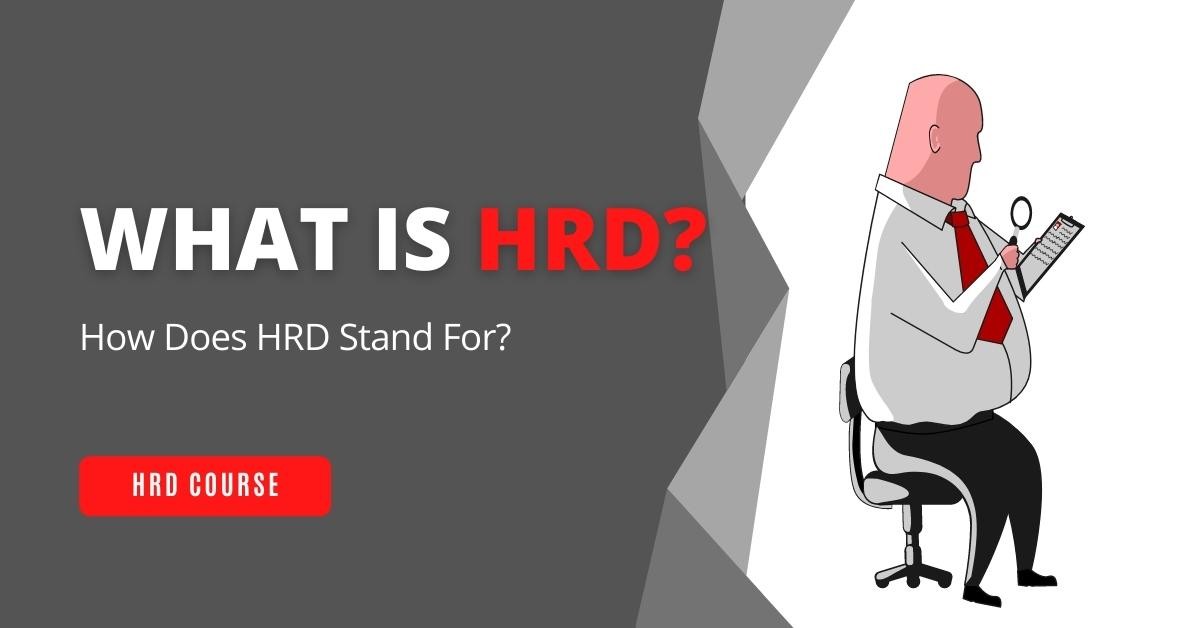
To understand the human resources goals, we should first look at the human resources management functions. And also we should take consider their duties. This is because there are so many fields of human resources management.
What Is Human Resources Management Plan?
The human resources management plan is a company's business plan for its employees. Therefore, it should be developed in conjunction with the company's business and marketing plans and services to advance the goals of all three documents. In addition to providing a brief summary of an employee's education, experience, and work history, the professional development plan must also indicate what types of continuing education have been completed by the employee.
Now you are ready to address the various aspects of human resource management, including recruitment, selection, training and development, career advancement, compensation and benefits administration, performance appraisal, and disciplinary procedures:
Related Course: Hr Certificate Programs
Recruitment refers to circling back to employee referrals or reaching out to individuals who have been identified as potential candidates for employment.
Selection refers to making a hiring decision. You must now choose the person from those interviewed who is most qualified and meets all job requirements as stated in your company's adoption statement.
The training and development step provides employees with the necessary tools to do their jobs well. For example, training might include taking a class related to the job or attending a trade conference.
Career advancement provides employees with opportunities for growth within your company. For example, you might offer promotional opportunities, transfer opportunities, and/or lateral moves that will challenge your employee without causing burnout.
Performance appraisal is a formal review of an employee's performance which allows you to provide feedback on strengths and areas that need improvement. In addition, the process offers an opportunity for dialogue between you and your employees.
Disciplinary procedures are necessary when an infraction has been committed that warrants corrective action.
What Should Be Done To Achieve Human Resources Management Goals?
Communication, workforce assessment, training, and employee complaints and demands are integrated, and they should be assessed together. We handle all of them:
Conducting an estimate of the workforce
The workforce is a significant component of the American economy. However, to be successful, it must have a stable and happy workforce. By conducting an assessment on mental capabilities, a company can identify each employee's skill level and how far along they are in their professional development. This allows them to help employees move forward in their career paths in a constructive manner.
The assessment of the workforce can help companies in many different ways. It will show where people excel and where they are lacking, allowing for them to be placed into positions that fit their skillset and allow for improvement in areas that may be more difficult. This also helps employees identify weaknesses before reaching a crisis point and prevents them from making the same mistake twice. This also allows companies because conduct this type of assessment can help ensure that they are hiring the best employees possible, as those who do not meet specific standards will be identified early on in their employment.
Long Tail Keyword For Human Capital Management İn Organizational Success
The Role Of Corporate Hr İn Uniting Departments And Creating A Unified Hrm Strategy
Properly assessing the workforce can be a difficult task, but ensuring all mental capabilities and strengths and weaknesses of employees is an essential step towards ensuring success for companies across America. In addition, by following specific actions, such as those mentioned above, companies can take their business to new heights and help their employees succeed.
Communicating with employees about HR policies and procedures
Although it is known that establishing effective employee relationships is an essential part of the business process, many challenges can arise in trying to do so. One of the significant factors that will affect these relations is the issue of communicating with employees about how HR policies and procedures affect them on a day-to-day basis.
Employee retention directly correlates with the extent to which employees feel that they are in control or know what is in store for them. However, when employees are in the dark about certain aspects of their jobs, this can lead to confusion and disinterest. Therefore, two things must be constantly avoided if there is hope for positive employee relationships moving forward.
Ensure that your communication is clear and concise. When employees feel that they are being talked down or patronized, this can further alienate them from you, which is to be avoided at all costs.
In addition, being specific will go a long way in how employees understand the policies and procedures that they are expected to follow. Let them know what is expected of them and inform them what you expect from them in return for doing so.
Do not be dismissive of your employees’ feelings and concerns. Dismissing their opinions or ideas can cause resentment on the workers; it is best to appreciate their input-even if you disagree with it. By adhering to these strategies as best as you can, you will find that your employees feel more confident in communicating with you and those around them.
Implementing effective training programs for new hires or existing employees
Training programs are essential to the development of employees within an organization.
An excellent place to start is defining clear goals with your team members. Each program should align well with what all parties want out of their experience at this point.
How much did we learn, and how will it apply back on-site? It is also important to note that each person has different strengths and weaknesses, so you should consider this as well.
Training methods should take into account the type of learning you want and the environment in which you are training. For example, suppose your employees work on live projects during their first week of employment. In that case, it might be challenging to try and incorporate formal training methods.
Ensure everyone is adequately trained before allowing them to use their new skills or knowledge. If possible, try to reach this goal in the shortest time possible.
If you follow these tips, you should have more effective training programs for new hires or existing employees in no time.
Dealing with employee complaints, grievances, and disciplinary matters
When someone has expressed concerns about their job performance or interactions in the workplace, you should consider this to be an official complaint. When you receive an actual written or verbal complaint, follow the appropriate company protocols for handling it (usually documented in your employee manual). Make sure to fix any discovered problems and write up a statement that addresses each of the complainant's concerns. Document everything said and done during this process, especially if you have to discipline the worker.
If an employee files a grievance about their employment status (for example, if they believe they've been discriminated against), it's best to address these concerns. Even though it might seem tempting to claim innocence, don't make claims that you can't back up or make insensitive comments. The best way forward is to acknowledge the grievance and suggest a fair solution for all involved. Be open to negotiating as long as the outcome will be reasonable for everyone involved.
If an employee files a complaint about your behavior, it's generally best to address this matter right away. Don't make excuses - if you said something inappropriate, apologize for it and move forward. While some mistakes are unforgivable, many of them can be put in the past with an apology. If your employee doesn't feel you've addressed the problem, she can take her complaint up with your boss or HR department.

Frequently Asked Questions
What is the main goal that HR is trying to achieve in an organization?
Main Goal of HR in Organizations
Organizational Success and Employee Satisfaction
The primary goal that Human Resources (HR) aims to achieve in an organization is striking a balance between employee satisfaction and overall organizational success. As a facilitator of optimal functioning, HR works to ensure strong communication, collaboration, and harmony among employees and departments.
Effective Talent Acquisition and Management
To materialize this goal, HR focuses on effective talent acquisition and management practices. The HR department searches for skilled and diverse candidates to join the organization, thereby enriching the team with fresh perspectives and expertise. By establishing clear policies and procedures for hiring, onboarding, and integrating new employees, HR professionals help create a positive and inclusive work environment.
Continuous Development and Training
To maintain the satisfaction of the workforce, HR departments also emphasize continuous development and training opportunities for employees. By providing resources and encouragement to acquire new skills and knowledge, HR aids in fostering a culture of growth and innovation. Consequently, well-trained and motivated employees tend to be more productive and efficient, leading to organizational success.
Performance Management and Employee Engagement
Another crucial aspect of HR's mission is performance management and employee engagement. By setting clear expectations and conducting regular performance evaluations, HR helps employees understand their roles and responsibilities better, promoting both individual and team growth. Besides, by organizing employee engagement initiatives and recognizing efforts, HR can boost morale and help retain top talent.
Conflict Resolution and Compliance
Finally, HR plays a vital role in conflict resolution and compliance with labor laws and regulations. As the mediator for employee grievances, HR develops fair and transparent policies for salary, benefits, and promotions to avoid potential conflicts. Moreover, HR ensures compliance with all relevant laws and regulations, protecting both the employees' and organization's interests.
In conclusion, the primary goal of HR in organizations is to ensure employee satisfaction while driving organizational success. To achieve this, HR focuses on talent acquisition and management, continuous development and training, performance management and employee engagement, and conflict resolution and compliance. These practices work cohesively to create a positive work environment that ultimately results in increased productivity and profitability for the organization.

How can organizations align their human resource strategies with business objectives to achieve success?
Aligning HR Strategies with Business Objectives
Understanding Business Objectives
Successful organizations begin by clearly defining their overall business objectives, such as financial performance, market share, and product or service innovation. Human resource (HR) leaders play a critical role in understanding and connecting with these objectives to ensure strategic alignment between the HR department and organizational goals.
Integrating HR and Business Strategies
To achieve success, organizations must ensure that their HR strategies are integrated with and support their overall business strategy. This integration can be achieved by developing HR policies and practices that are designed to enhance employee performance, increase employee engagement, and create an organizational culture conducive to achieving business objectives.
Strategic Workforce Planning
Aligning HR strategies with business objectives involves carrying out strategic workforce planning. This process involves assessing current workforce capabilities, identifying future workforce needs, and developing strategies for closing the gaps between them. It enables organizations to optimize their human capital by aligning their workforce with their strategic objectives.
Developing Performance Management Systems
An essential element of aligning HR strategies with business objectives is the implementation of a performance management system that focuses on achieving organizational goals. These systems help organizations measure and manage employee performance, ensure individual employee goals are aligned with organizational objectives, and facilitate the identification and development of high-potential employees.
Promoting a Culture of Continuous Learning
Organizations can achieve success by fostering a culture of continuous learning, where employees are encouraged to acquire new skills and knowledge that will help them align their objectives with those of the organization. This can be achieved through training and development programs, mentorship, and other learning opportunities tailored to the organization's strategic priorities.
Involving Employees in Decision-making Processes
Employee involvement in decision-making processes not only enhances commitment to organizational goals but also ensures that the perspectives of the employees who will be executing the strategies are taken into consideration. Through collaboration, HR leaders can ensure that the company's workforce is aligned with and supports the business objectives, ultimately contributing to the organization's overall success.
In conclusion, organizations can attain success by aligning their HR strategies with business objectives through integrating HR and business strategies, strategic workforce planning, developing performance management systems, promoting a culture of continuous learning, and involving employees in decision-making processes. These measures ensure optimal human capital utilization and foster a highly motivated and committed workforce that drives organizational success.

What are the essential steps in implementing effective human resource management practices to achieve HRM goals?
**Understanding HRM Goals**
To implement effective human resource management (HRM) practices, it is crucial to first understand the HRM goals. These typically include attracting and retaining top talent, ensuring a skilled and diverse workforce, fostering employee engagement, promoting a healthy organizational culture, and optimizing organizational performance.
**Developing HRM Strategies**
After identifying the HRM goals, organizations need to develop well-defined strategies to achieve these objectives. This involves conducting a thorough analysis of current HRM practices and identifying areas requiring improvement. Based on this, tailored strategies should be designed to address the specific needs of the organization and incorporate various HR functions, such as recruitment, performance management, and employee development.
**Establishing HR Policies and Procedures**
To support the HRM strategies, organizations must create and implement clear, concise, and legally compliant HR policies and procedures. This ensures that employees have a consistent understanding of organizational expectations, provides managers with guidelines for decision-making, and establishes a framework for applying fair and equitable practices in the workplace.
**Training and Developing Staff**
For HRM practices to be effective, all members of the organization must understand their role in achieving HRM goals. This requires ongoing training programs and workshops for employees and managers, focusing on various aspects of HRM. Through these initiatives, employees can learn about the company's values, goals, and expectations, while managers can develop the leadership skills necessary to drive employee performance and engagement.
**Implementing Performance Management Systems**
Effective HRM practices rely on robust performance management systems (PMS). These systems facilitate ongoing monitoring, evaluation, and feedback, enabling organizations to assess employee progress, identify areas for growth and development, and ensure alignment with organizational objectives. An effective PMS should be transparent, objective, and flexible to adapt to changing business requirements.
**Creating a Culture of Continuous Improvement**
Lastly, organizations should foster a culture of continuous improvement as part of their HRM practices. This means regularly reviewing and updating HR strategies, policies, and procedures to address emerging challenges and opportunities. By promoting open communication and collaboration, organizations can encourage the sharing of ideas, knowledge, and best practices, resulting in more efficient and effective HRM practices.
In conclusion, achieving HRM goals requires organizations to take a comprehensive approach to managing human resources by understanding the goals, developing effective strategies, establishing policies and procedures, training and developing staff, implementing performance management systems and fostering a culture of continuous improvement. Through these essential steps, organizations can create a high-performing and engaged workforce that contributes to achieving overall business objectives.
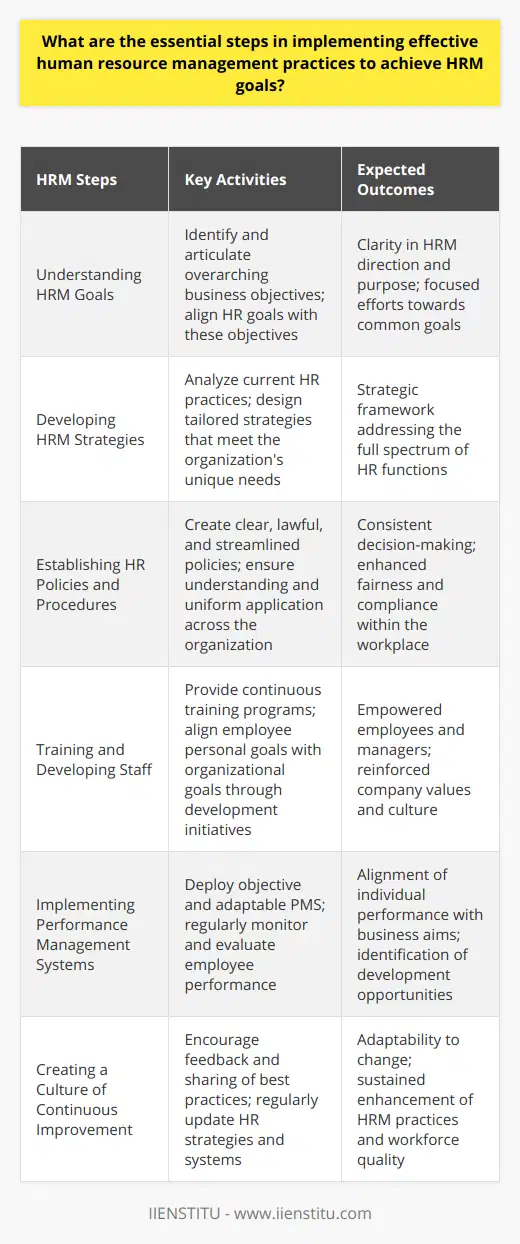
What are the critical factors to consider when developing a human resource strategy to ensure organizational success?
Understanding Critical Factors
To ensure organizational success while developing a human resource strategy, it is essential to consider several critical factors. Firstly, alignment with organizational goals is pivotal to achieve desired results. The HR strategy should support the company's overall objectives, ensuring that its policies and procedures contribute towards growth and sustainable development.
Analyzing Workforce Requirements
Understanding and catering to workforce requirements is another crucial aspect. HR professionals must conduct regular assessments to identify skill gaps, employee expectations, and demographic trends. This information will guide strategic decisions, aiding in the retention and attraction of top talent.
Strengthening Leadership Development
Developing leadership is also a vital component of a successful HR strategy. Organizations should invest in training and development programs to nurture future leaders and managers. Providing growth opportunities enables employees to excel, consequently leading to a more productive and innovative work environment.
Implementing Performance Management Systems
A robust performance management system is essential for measuring and tracking employees' performance. It enables HR professionals to set clear expectations, provide feedback, and recognize achievements. Performance management systems not only improve motivation and engagement but also support employee development and organizational goals.
Promoting Diversity and Inclusion
Promoting diversity and inclusion in the workplace is a fundamental factor in successful HR strategies. Inclusive policies and practices foster a culture of mutual respect and belonging, unlocking the unique potential of each employee. Embracing diversity boosts creativity, innovation, and problem-solving capabilities, ultimately contributing to organizational success.
Leveraging Technology for Efficiency
Effective use of technology can streamline HR operations and enhance decision-making. Tools like human resource management systems (HRMS), artificial intelligence (AI), and analytics can automate repetitive tasks and provide valuable insights into employee behavior and preferences. Leveraging technology not only improves efficiency but also supports data-driven decision-making.
Ensuring Legal Compliance and Workplace Ethics
Lastly, legal compliance and workplace ethics are major considerations. HR strategies should incorporate policies that adhere to relevant laws and regulations, ensuring fair treatment of employees and minimizing risks of legal issues. Additionally, cultivating an ethical work environment promotes trust, transparency, and accountability, leading to a well-functioning organization.
In conclusion, a successful human resource strategy should address workforce requirements, leadership development, performance management, diversity and inclusion, technology, legal compliance, and workplace ethics. By considering these critical factors, organizations can create an effective HR strategy to drive organizational success.

How can organizations effectively measure the success of their human resource management efforts?
Establishing Clear Metrics
To effectively measure the success of their human resource management efforts, organizations must first establish clear metrics that align with their strategic objectives. By defining specific indicators and outcomes, organizations can better evaluate the efficacy of their HR strategies.
Monitoring Employee Performance
One crucial area where organizations can assess the success of their HR management efforts is through employee performance. Tracking productivity, efficiency, and achievement of performance goals provides valuable insights into the effectiveness of HR practices, such as recruitment, training, and talent development. Additionally, regular performance appraisals and feedback systems enable organizations to continually adjust their HR strategies to optimize employee performance.
Measuring Employee Engagement
Another key aspect of successful HR management is gauging employee engagement levels. Employee surveys, focus groups, and one-on-one discussions can provide valuable insights into employee satisfaction, motivation, and commitment. These tools can help organizations identify areas for improvement in their HR strategies and foster greater employee loyalty and retention.
Assessing Turnover and Retention Rates
Examining turnover and retention rates can also be an effective way to measure the success of human resource management efforts. High retention rates and low turnover levels suggest that HR strategies are effectively fostering a positive work environment and addressing employee needs. Conversely, organizations with frequent employee departures may need to reassess their HR processes and policies to identify areas of concern.
Quantifying HR's Impact on Organizational Goals
Finally, organizations must evaluate HR's contributions to broader organizational goals, such as revenue growth, cost savings, and innovation. By quantifying the direct and indirect impact of HR management efforts, organizations can better understand the overall effectiveness of their HR strategies and make informed decisions about resource allocation and future investments in HR initiatives.
In conclusion, organizations can effectively measure the success of their human resource management efforts through a combination of clearly defined metrics, continuous monitoring of employee performance and engagement, examination of turnover and retention rates, and assessing HR's impact on organizational goals. By focusing on these key areas, organizations can optimize their HR strategies, drive employee satisfaction, and ultimately contribute to the organization's overall success.

In what ways do the elements of a comprehensive human resource management system contribute to the achievement of organizational goals?
Organizational Goal Alignment
A comprehensive human resource management (HRM) system plays a critical role in aligning the workforce with organizational goals. By effectively implementing HR practices, businesses ensure that all employees understand and work towards achieving common objectives.
Talent Acquisition and Retention
One significant element is talent acquisition and retention, which focuses on attracting competent candidates and retaining valuable employees. A well-designed HRM system ensures that the organization hires individuals who possess the required skills and are aligned with its vision and mission. Moreover, they promote employee engagement and maintain job satisfaction, resulting in higher retention and reduced turnover rates.
Employee Training and Development
Effective employee training and development programs enhance the skills and competencies of the workforce. A comprehensive HRM system facilitates continuous learning, ensuring that employees remain proficient and up-to-date with industry changes. Moreover, these programs develop individual capabilities, preparing employees for future internal opportunities, thus supporting overall organizational growth.
Performance Management
Efficient performance management assists organizations in measuring employee productivity and success. An HRM system can create a transparent evaluation process that sets clear performance objectives for all employees. Through regular feedback and constructive coaching, performance management tools help employees continuously improve and adjust their efforts to contribute to organizational success.
Compensation and Benefits
Fair and equitable compensation and benefits packages serve as motivation for employees to perform at their best. An HRM system should involve strategic design and management of compensation policies that adequately reward employees for their contributions. Furthermore, benefit packages tailored to employee needs ensure that they feel valued and satisfied, ultimately leading to higher retention rates.
Workplace Culture
A positive and inclusive workplace culture enhances employee productivity and commitment, which in turn boosts overall organizational performance. HRM systems play a crucial role in creating a nurturing and inclusive work environment by promoting diversity, equal opportunity, and effective communication. They also implement policies to prevent and address workplace conflicts and issues, thus fostering a collaborative and supportive atmosphere.
In conclusion, elements of a comprehensive HRM system contribute significantly to achieving organizational goals. Through strategic talent acquisition, employee development, performance management, compensation planning, and nurturing workplace culture, HRM systems enable businesses to align workforce efforts with overall objectives and maintain sustained growth.
